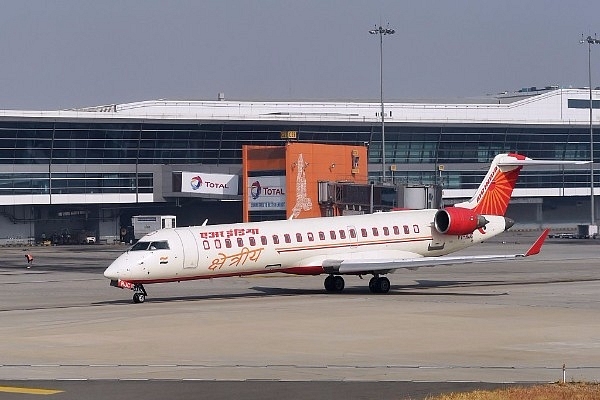
Why Modi Shouldn’t Have Tom-Tommed Air India’s Brief Flirtation With Profit
During his Independence Day speech, Modi claimed that his government succeeded in bringing Air India to a situation of profit.
This is, however, a dubious claim since Air India has only made an “operating profit” - something that cannot be presumed to continue.
One of the few
dubious claims Narendra Modi made during his Independence Day speech was about bringing Air India back to profits. “Air India was infamous for
incurring losses. My government has succeeded in bringing Air India to a
situation of clocking operational profit,” he said.
That should be
news to most of us. Not that the airline is losing money, but what it has made
is an “operating profit” – that is, a cash profit before setting off other key
costs and carry-forward losses. A Business Standard report notes that the
airline may have made an operational profit of around Rs 100-110 crore in
2015-16, which at best means that it is not continuing to bleed. But the real
numbers are likely to be a fresh loss of Rs 2,636 crore in 2015-16, but down from the
massive Rs 5,859 crore in the year before. Even this has been possible only due
to the Rs 30,000-crore bailout from government, of which Rs 22,280 crore has
already been disbursed.
But this
situation of operational profit cannot be presumed to continue. Last year,
every private airline was making money hand over fist due to the steep decline
in jet fuel prices. Jet Airways, which reported its
biggest ever loss in 2014-15, disclosed its biggest-ever profit in 2015-16 of
Rs 1,173 crore. SpiceJet, which was skidding badly in 2014-15 when the Marans
of Sun TV handed over the company to Ajay Singh, reported a Rs 407-crore profit
in 2015-16. So it is hardly a surprise that Air India too managed to keep its
head above water.
But with fares
remaining competitive, 2016-17 will separate the men from the boys. Jet
Airways, which reported its first quarter results last week, saw a sharp 53
percent fall in standalone profits to Rs 103 crore from Rs 221 crore in the
corresponding quarter of 2015-16. Naresh Goyal, the Jet Chairman, had this to
say: “Due to the intense competitive environment, industry yields were under
pressure in Q1 and the trend is expected to continue in Q2.”
It is thus
unlikely that Air India is going to shine like a diamond this year, especially when its more
competitive peers too are saying the going is tough.
However, the
real reason why the Prime Minister should not expect any miracles from Air
India in future is simple: it has a faulty public sector DNA, and it simply
does not have the right cost structure or business model to be profitable in
the long run. It will be sorely tested the minute the cheap fare jamboree ends.
Worse, it has the most unionised employee base, thus making it less amenable to
cost reductions.
Air India
claims a current aircraft-to-employee ratio of 114 while industry leader
Indigo’s figures are around 102 per plane. But Air India managed to achieve
this only by hiving off labour-intensive functions like ground handling, engineering
and MRO (maintenance, repair, operations) services to get here. It chopped off
muscle to show less flab.
Air India is
now a distant No 3, with a market share of just 15.5 percent, far behind
Indigo’s 37.9 percent in June 2016 and Jet’s 19.1 percent. It is not the
price-setter, and is in no shape to set the terms in the Indian aviation
market.
India’s
airline market is now decidedly a low-fare one, and the one calling the shots
is Indigo, which supported its price-driven strategy with an excellent business
model, which includes using only one kind of aircraft (A 320), one single-class
configuration, the youngest fleet (to keep fuel and maintenance costs low), and
the longest flying duration (to maximise miles flown per day).
Indigo’s
superior business model was what enabled it to fly past Jet, SpiceJet, Air
India and (the now-defunct) Kingfisher, allowing it to slowly build scale and
market share from where nobody can challenge it.
As authors
Richard Koch and Greg Lockwood note in their book, Simplify: How the Best
Businesses in The World Succeed, “price simplifiers” not only offer the best prices
to customers, but by building scale, they can generate enough volumes to demand
even lower prices from their suppliers and partners, thus making their business
models even stronger. Once a “price simplifier” achieves dominant status and
scale, it will be practically unbeatable, as all factors work in his favour.
So Air India,
with its multiple types of aircraft and seat configurations and public sector
work culture, is unlikely to ever beat Jet or SpiceJet, leave alone Indigo. The
only thing Modi may have ensured is less political interference, but the
absence of one negative does not mean Air India is flying fit.
Modi is likely
to discover that while public sector airlines – in fact, all public sector
companies – can be run much better, and even profitably, they will never be
able to fight off the competition, especially after the latter have established
themselves as leaders in the market.
The only
options before Air India are either closure, downsizing or privatisation. Since
Air India’s physical assets may be the only thing worth selling (its
balance sheet will enable a price of Re 1 at best), the recent turnaround in
terms of operating profits is hardly something for Modi to tom-tom.
Air India is
unlikely to be the jewel in anybody’s crown, leave alone the taxpayer’s. Modi
should be trying to figure out how to bury it or sell it without incurring
further losses.